
The ACT English section can feel a bit overwhelming. You have to answer 75 questions in 45 minutes. You have to know and understand grammar rules. You have to analyze phrases, sentences, paragraphs, and whole passages. It can be scary stuff.
If you can focus on a few basic tips, you can simplify the ACT English section and feel more confident when attempting to slay the ACT English beast. Whether you spend ample time diligently studying for the ACT or start your ACT preparation the night before the test, remembering these tips for the ACT English section will be beneficial on test day.
In this article, I'll give you the top 8 tips for ACT English success. Using these tips will raise your score and prevent you from making careless mistakes:
- Read the Whole Sentence
- Don't Be Afraid to Pick NO CHANGE
- Don't Rush
- Rely on Rules, Not Your Ear
- Be Sure You Know the Easy, Common Rules
- Eliminate Identical Answers
- Pick the Clearest Answer
- Answer the Question that You're Asked
General ACT English Tips
Let's start with some strategies that apply to the ACT English section as a whole.
#1: Read the Whole Sentence
This tip is vital for the ACT English section. Most of the questions will ask you how to change the underlined portion of a sentence. Don't just read the underlined portion. Reading the whole sentence is imperative to correctly answering the questions.
The phrases that are not underlined in the sentence often provide essential information to determine whether there is an error in the underlined portion.
Here is an example question from a real ACT to illustrate this point:
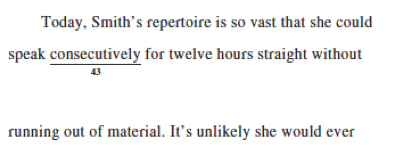

If you just look at the underlined portion, you probably won't think there is anything wrong with the word "consecutively." It's an adverb and it modifies the verb "speak."
However, when you read the whole sentence, you should notice that "consecutively" is redundant due to the phrase "for twelve hours straight." In this context, consecutively means without stopping, and the phrase "for twelve hours straight" implies that she could speak that long without stopping. Therefore, the word "consecutively" is superfluous.
If you don't read the whole sentence, you might not notice the error and most likely select A. However, because the word "consecutively" is unnecessary, the correct answer is D.
Additionally, some questions require you to read multiple sentences to correctly answer the questions. For example, you need the context provided by multiple sentences to answer some verb tense and paragraph order questions.

Remember to do enough reading.
#2: Don't Assume That There Must Be an Error
Do not fear the "NO CHANGE" option. If a sentence seems fine, look at the differences between the answer choices to understand what concept the question is testing and determine whether that error is present in the original sentence.
The NO CHANGE answer tends to be more common than expected if all answer choices were distributed evenly.
#3: Don't Rush
This tip may seem obvious, but it's important to think about as you're taking the test. Make sure you read and understand the relevant sentences and questions before marking your answer. It's better to have to guess at the end or skip the more time consuming big picture questions than to rush through questions and make careless mistakes.
Check out this question that you could easily miss if you were to rush:
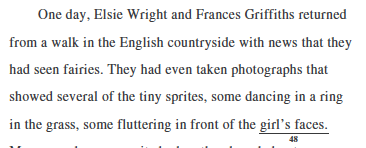

If you're going too quickly, you may miss this relatively easy question. Perhaps you won't notice that the apostrophe comes before the "s" in "girl's" and select NO CHANGE, or you may not recognize that we're dealing with a plural possessive noun.
The plural noun "faces" suggests that we're talking about more than one girl, and if you read the passage carefully, you'll know that the sentence is referring to the faces of Elsie Wright and Frances Griffiths. Therefore, the apostrophe should come after the "s" to indicate plural possession. The answer is G.
This question is testing a somewhat basic rule, but if you're not paying close enough attention, you can miss a question like this that you should be getting right.
Make sure you identify the type of question you're being asked, and go through all the necessary steps to find the correct answer. Refer to our ACT English articles in this blog for strategies for answering every type of question that appears on the ACT English section.

Grammar Tips
Here are some tips that focus exclusively on the grammar questions.
#4: Rely on Grammar Rules to Answer Grammar Questions
On the ACT English section, you should primarily use your knowledge of grammar rules to answer the grammar questions. Don't rely on your ear for what sounds right, except on idiom questions. Many correct sentences may sound wrong to you, and the ACT tests rules that are often broken in spoken and written English.
Take a look at this official ACT example:


If you attempt to answer this question by relying on what sounds right, you probably won't notice the error. The sentence sounds fine (at least it did to me when I first read it). However, if you rely on grammar rules to answer this question, you should first identify the underlined word as a pronoun. Whenever you see a pronoun underlined, you should check to see if there is an error in pronoun agreement.
In the sentence, the pronoun "them" doesn't have a clear antecedent. The only answer choice that corrects the error is G.
Here's an overview of all of the grammar rules that are tested on the ACT.
#5: Some Common Errors Are Relatively Simple to Fix
Some of the most common grammar errors on the ACT English section are fairly easy to fix. If you're able to identify these errors, often you can correct them with simple changes.
Redundancy/Wordiness
Redundancy and wordiness errors can be fixed by eliminating words or by making a sentence more concise. If a sentence makes sense without some of the underlined words, get rid of them.
Here is an example:
I think maybe I might possibly have met them all.
By just looking at the underlined phrase, you should be able to determine that this is a redundancy question because "might" and "possibly" are synonyms, and therefore, both words aren't necessary.
Additionally, the word "maybe" makes both "might" and "possibly" superfluous. All you have to do to eliminate the error is to get rid of "might" and "possibly." The correct answer is J.
Unnecessary Commas
Some of the comma questions on the ACT can be a little tricky and require you to know your comma rules well, but many comma questions simply require you to get rid of unnecessary commas. If you're unsure if a comma is needed, the general rule is to go with no comma.
Take a look at this question:
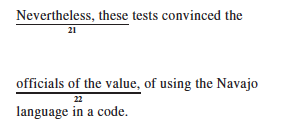

The sentence works just fine without the comma. On the ACT, if the sentence doesn't require a comma, there shouldn't be one. All you have to do to fix the error is get rid of the comma after "value." The correct answer is H.
Dangling Modifiers
If you start a sentence with a descriptive phrase, the word following the comma has to be the noun the phrase is describing. Any time you see an introductory phrase that describes a noun, the described noun should come right after the comma. This is an example of a dangling modifier:
A writer for PrepScholar, Justin's goal is to help prepare students for ACT success.
The introductory phrase is describing "Justin," not his goal. This sentence would fix the dangling modifier:
A writer for PrepScholar, Justin hopes to prepare students for ACT success.
#6: Eliminate Identical Errors
If two answers are functionally identical, they must both be wrong. For example, if there is a question about transitions and two of the answer choices are "furthermore" and "moreover," you can determine that both are wrong because there is no way to differentiate between the two options.
If you notice that more than two options are functionally identical, it will be a "Which of the following would not be acceptable?" question.
Let's take a look at one of our previous examples:
I think maybe I might possibly have met them all.
If you didn't initially notice the redundancy error, you could have started going through the answer choices. Look at choices G and H. There is no real difference between the phrases "perhaps I've met them all" and "I've possibly met them all." Therefore, you would be able to determine that they must both be incorrect, and you can eliminate them.
Then, you can compare the two remaining choices. Answer choice J is more concise, maintains the meaning of the original sentence, and it's grammatically correct, so it's the right answer.
Rhetorical Skills Tips
Now, here are some tips to use for the rhetorical skills questions.
#7: All Prose Should Be as Clear as Possible
Focus on picking the answer choice that provides all the necessary information and nothing more, in the most straightforward way possible. Here is an actual ACT example for you:
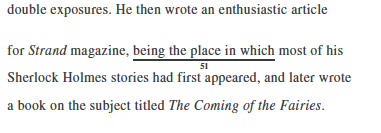

While the phrase "being the place in which" doesn't contain a specific grammatical error, it's unnecessarily wordy. Every word or phrase in the passages on the ACT English should serve an essential purpose. This sentence can be more straightforward and concise.
The correct answer is C. If we change "being the place in which" to "in which," none of the information in the sentence has changed, but the prose is more clear.
#8: You Must Answer the Question You're Being Asked
This tip may seem fairly obvious, but thinking about it is helpful when answering rhetorical skills questions. Each question asks you for specific things. Focus on selecting the answer choice that best answers the question instead of picking an answer choice that just seems plausible or sounds right.
Here is an example for you:

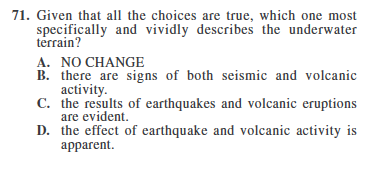
Many students will be stumped on questions like these. Since all the answer choices are true, they'll just randomly pick the choice that sounds formal and complex. Focus on the wording of the question. The correct answer should be the most specific and vivid. The answer choice that paints the clearest image of the underwater terrain will be the right answer.
By focusing on what the question is specifically asking, you should be able to determine that the correct answer is A. None of the other answer choices vividly describes the underwater terrain.
What's Next?
Review the posts on the five critical concepts you must understand to ace ACT English and formality on ACT English. Both offer some helpful insight into the English section of the ACT.
Also, read the article on how to approach ACT English passages. Make sure you have a systematic approach to these passages that works for you and will enable you to reach your target score.
Aiming for that elusive perfect 36? Try our guide to getting a 36 on the ACT English from a perfect scorer.











